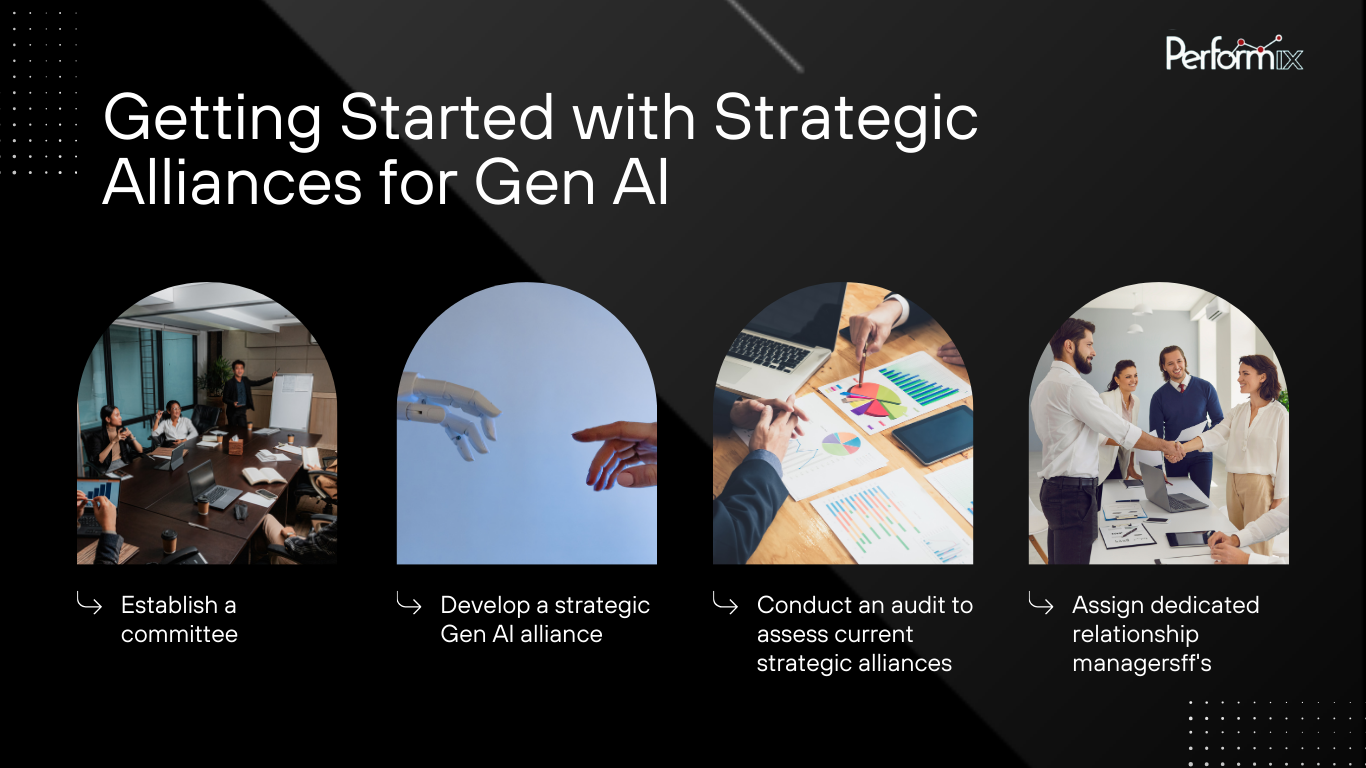The age of Generative AI (Gen AI) is upon us, promising to revolutionize businesses and unlock an estimated $4.4 trillion in annual economic impact. Companies across industries are jumping on board, fueled by the technology’s transformative potential. But simply acquiring Gen AI isn’t enough.
Companies need to rewire their approach and forge strategic alliances with Gen AI providers to capture its value truly.
Traditional vendor arrangements won’t cut it here. Gen AI’s unique challenges, from the lack of expertise to rapid technological change, demand a more collaborative approach.
Here at Performix, we understand the power of strategic alliances, and we’re here to guide you through building successful ones in the Gen AI landscape.
Why Go Beyond “Going It Alone”?
Many companies are already experimenting with Gen AI providers. However, outdated ideas about what to look for and how partnerships should function can hinder progress. To maximize the benefits of Gen AI alliances, companies should focus on three key areas:
- Deeper Collaboration: Working with Gen AI providers requires more trust and collaboration than traditional vendor relationships. This means fostering transparency, frequent communication, and alignment across planning, development, and ongoing management.
- Scalability, Interoperability, and Reusability: No single provider can offer everything. Look for partners with solutions that can scale with your needs, work seamlessly with other components in your ecosystem, and be reused across different projects.
- Maintaining Control: It is crucial to balance leveraging a provider’s capabilities and becoming overly dependent. Invest in flexible infrastructure, monitor provider performance, and tie compensation to outcomes.
Collaboration is Key: Why Traditional “Build vs Buy” Doesn’t Work
Building Gen AI solutions entirely in-house is time-consuming and resource-intensive, especially with the current talent shortage. While buying existing products offers quick access, they often require customization, necessitating skilled Gen AI personnel.
Collaboration provides the best of both worlds: access to cutting-edge capabilities, faster development, and tailored solutions. However, effective Gen AI alliances require a different approach than traditional vendor relationships. Here’s how to build trust and foster successful collaboration:
- Co-create Solutions: Most companies will achieve the highest value by adapting established capabilities from providers to their unique data. This requires a collaborative process where both parties work together on data sourcing, prompt engineering, model fine-tuning, and testing.
- Joint Planning: Transparency is key. Encourage your provider to share their roadmap and consider offering access to alpha or beta releases. This lets you anticipate how their offerings evolve and influence their direction. Sharing your strategic goals and customer insights will help them better understand your needs.
- Risk and Investment Sharing: Gen AI programs often require significant investments in hardware, data acquisition, and computational resources. Additionally, potential risks like model instability and privacy concerns need careful consideration. Discuss how best to share financial, technological, and operational resources and manage development risks.

Choosing the Right Partners: It’s Not Just About the Technology
Finding a single provider that offers all the best components for an effective Gen AI solution is (at least for now) a fantasy. Building a thriving ecosystem necessitates partnering with a curated network of specialized providers. Here are three key criteria to consider when selecting them:
- Scalability: Can the provider handle increased volumes of data and user queries without compromising performance? Look for demonstrably scalable solutions and providers willing to commit to specific milestones, such as handling a percentage increase in user queries without degradation.
- Reusability: Reusing code can significantly accelerate Gen AI development. Look for providers offering flexible, modular components and pre-trained models that can be adapted across various contexts. Tools and frameworks facilitating customization and extension of solutions, such as intuitive APIs and drag-and-drop interfaces, should be considered.
- Interoperability: Ensure your chosen providers’ models and components work seamlessly together. Find providers that adhere to industry standards and best practices for data exchange, API design, and software development. They should utilize widely adopted programming languages, offer well-documented APIs, and smoothly integrate with your existing data sources and platforms.
Staying in Control: Maintaining Agency in Your Alliances
Finding the sweet spot between forging strong alliances and maintaining control over your vision presents a challenge. Here are some guidelines to ensure your independence:
- Establish a Flexible Infrastructure: A scalable Gen AI infrastructure is the foundation for integrating different providers. This “chassis” could be a centralized platform or a set of well-defined APIs, protocols, and data formats. Consider adopting MLOps best practices to ensure reliability, performance, and rapid change rollbacks.
- Continuously Monitor Model Performance:
- Avoid a “black box” situation.
- Ensure providers include proper documentation and transparency during development.
- Implement robust monitoring and testing capabilities to track provider performance and identify issues early.
- Regularly conduct end-to-end tests to track performance and pinpoint problems across the provider ecosystem.
- Establish Clear IP Boundaries: Gen AI and intellectual property are evolving together. Negotiate clear boundaries upfront. Specify the existing IP each party brings (data sets, algorithms, models). Define ownership and management of IP created during collaboration (patents, copyrights, trade secrets). Outline a process for tracking and attributing contributions to co-developed IP to prevent disputes.
- Tie Compensation to Outcomes: Go beyond traditional contracts and service-level agreements and link provider compensation to measurable outcomes like model accuracy, uptime, and user satisfaction. Avoid minimum spend requirements and include clear exit clauses and data portability requirements to maintain flexibility.

Getting Started with Strategic Alliances for Gen AI
The transformative power of Gen AI is undeniable. Companies that act decisively will position themselves for success in this new era. Get started:
- Steering Committee: Establish a committee with key stakeholders from business, IT, legal, and procurement to oversee the Gen AI alliance strategy. This committee should define alliance criteria, set performance metrics, and establish governance guidelines with the autonomy to make informed decisions.
- Strategic Playbook: Develop a strategic Gen AI alliance playbook with a standardized framework for evaluating, onboarding, and managing new providers. This framework should include guidelines for assessing scalability, reusability, and interoperability, along with templates for contracts, service-level agreements, and performance dashboards.
- Strategic Alliance Audit: Conduct an audit to assess current strategic alliances and identify gaps, redundancies, or misalignments with your Gen AI strategy. Determining which alliances to maintain, expand, or phase out is based on their potential to drive business value.
- Dedicated Relationship Managers: Assign dedicated relationship managers with a solid understanding of Gen AI technologies, architectures, and best practices. These managers will effectively communicate with providers, assess capabilities, ensure alignment with your technical requirements, and oversee the entire Gen AI ecosystem. Consider including a solution architect and holding regular meetings with providers to understand their progress.
Building successful Gen AI alliances takes more than just choosing the right technology. It’s about fostering trust, collaboration, and a shared vision. By following these steps and partnering with the right companies, you can unlock the full potential of Gen AI and revolutionize your business.
Don’t Go It Alone in the Age of Generative AI—partner with Performix.
We can help you build strategic alliances and find the talent and technology partners for your Gen AI journey.






